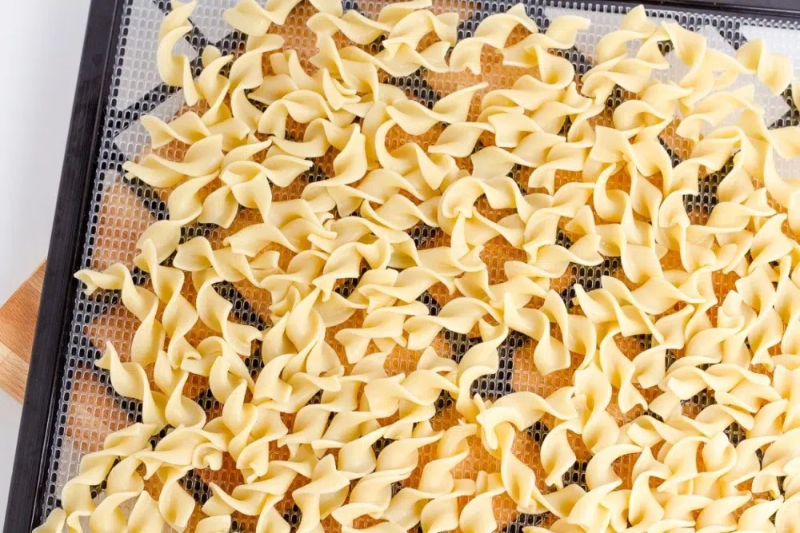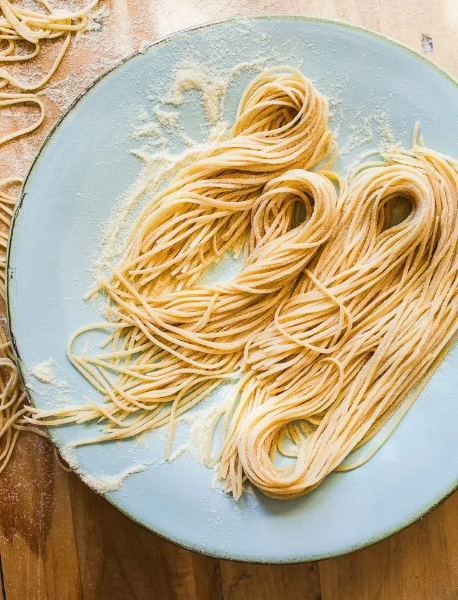
Content Menu
● Introduction to Dehydrating Egg Noodles
>> Benefits of Dehydrating Noodles
● How to Dehydrate Fresh Egg Noodles
>> Step 1: Prepare the Noodles
>> Step 2: Prepare the Dehydrator
>> Step 3: Dehydrate the Noodles
>> Step 4: Check for Dryness
>> Step 5: Equalize and Condition
● Tips for Successful Dehydration
● Additional Considerations for Dehydrating Noodles
>> Choosing the Right Dehydrator
>> Rehydrating Dehydrated Noodles
>> Nutritional Considerations
● Conclusion
● Frequently Asked Questions
>> 1. What is the best temperature for dehydrating egg noodles?
>> 2. How long does it take to dehydrate egg noodles?
>> 3. Can I dehydrate homemade egg noodles?
>> 4. How do I store dehydrated noodles?
>> 5. How long can dehydrated noodles be stored?
● Citations:
Dehydrating fresh egg noodles is a practical way to preserve them for longer periods, making them ideal for backpacking, camping, or emergency food supplies. This process involves using a food dehydrator to remove moisture from the noodles, thereby extending their shelf life and reducing storage space. In this article, we will explore how to dehydrate fresh egg noodles using a dehydrator, discuss the benefits of dehydrating noodles, and provide tips for optimal results.

Introduction to Dehydrating Egg Noodles
Dehydrating egg noodles is a straightforward process that requires minimal equipment. The primary tool needed is a food dehydrator, which circulates warm air around the noodles to evaporate moisture. This method is not only useful for preserving noodles but also for creating lightweight, compact meals perfect for outdoor activities.
Benefits of Dehydrating Noodles
1. Longer Shelf Life: Dehydrated noodles can be stored for up to a year or more when properly sealed and stored in a cool, dry place.
2. Space Efficiency: Removing moisture significantly reduces the volume of the noodles, making them easier to store and transport.
3. Weight Reduction: Dehydrated noodles are much lighter than their fresh counterparts, which is beneficial for backpackers and campers.
4. Easy Rehydration: Dehydrated noodles rehydrate quickly in boiling water, making meal preparation simple.
How to Dehydrate Fresh Egg Noodles
Dehydrating fresh egg noodles involves several steps:
Step 1: Prepare the Noodles
- Cook the Noodles: Cook the fresh egg noodles according to the package instructions. It's crucial to avoid adding fats or oils during cooking, as they can interfere with the dehydration process.
- Drain and Cool: Drain the cooked noodles and let them cool slightly. This step helps prevent the noodles from sticking together during dehydration.
Step 2: Prepare the Dehydrator
- Set Up Trays: Use removable mesh screen inserts for each dehydrator tray. These inserts help prevent the noodles from sticking to the trays.
- Layer the Noodles: Spread the cooled noodles in a single layer on each tray. Ensure the noodles are not overcrowded, as this can lead to uneven drying.
Step 3: Dehydrate the Noodles
- Temperature Setting: Set the dehydrator to 135°F (57°C) for egg noodles. This temperature is optimal for preserving nutrients and preventing over-drying.
- Drying Time: Dehydrate the noodles for 8 to 12 hours. The exact time may vary depending on the dehydrator model and ambient conditions.
Step 4: Check for Dryness
- Break Test: Once the dehydration cycle is complete, perform a break test. Dehydrated noodles should break easily when bent. If they still feel moist or flexible, return them to the dehydrator for additional drying time.
Step 5: Equalize and Condition
- Cooling and Storage: Allow the dehydrated noodles to cool completely before storing them in airtight containers. This step is crucial to prevent moisture buildup.
- Equalization: Store the noodles in a large container for 7 to 10 days, shaking the container daily to ensure even moisture distribution. If clumping occurs, return the noodles to the dehydrator for further drying.

Tips for Successful Dehydration
- Monitor Humidity: Ensure the storage area is dry to prevent rehydration.
- Use Desiccants: Optional desiccant packets can help maintain dry conditions in storage containers.
- Label Containers: Clearly label containers with contents and date for easy inventory management.
Additional Considerations for Dehydrating Noodles
Choosing the Right Dehydrator
When selecting a dehydrator for drying noodles, consider the following factors:
- Capacity: Ensure the dehydrator has enough trays to accommodate the amount of noodles you plan to dehydrate.
- Temperature Control: Look for a dehydrator with precise temperature control to maintain the optimal drying temperature.
- Noise Level: If you plan to use the dehydrator in a residential area, consider a model with a low noise level.
Rehydrating Dehydrated Noodles
Rehydrating dehydrated noodles is straightforward:
1. Boiling Water: Place the dehydrated noodles in boiling water.
2. Cooking Time: Allow the noodles to rehydrate for about 5 to 10 minutes, or until they reach the desired texture.
3. Seasoning: Add your preferred seasonings or sauces to the rehydrated noodles.
Nutritional Considerations
Dehydrating noodles helps preserve their nutritional content. However, it's essential to note that some vitamins, especially water-soluble vitamins like vitamin C and B vitamins, may be lost during the cooking and dehydration process. To maximize nutritional retention, cook the noodles briefly before dehydration and store them properly to prevent moisture exposure.
Conclusion
Dehydrating fresh egg noodles in a dehydrator is a simple and effective way to preserve them for extended periods. This method not only saves space and weight but also ensures that you have a reliable food source for camping trips or emergency situations. By following the steps outlined above and using the right equipment, you can enjoy dehydrated noodles that rehydrate quickly and retain their nutritional value.

Frequently Asked Questions
1. What is the best temperature for dehydrating egg noodles?
The optimal temperature for dehydrating egg noodles is 135°F (57°C). This temperature helps preserve nutrients while ensuring effective moisture removal.
2. How long does it take to dehydrate egg noodles?
Dehydrating egg noodles typically takes between 8 to 12 hours, depending on the dehydrator model and ambient conditions.
3. Can I dehydrate homemade egg noodles?
Yes, you can dehydrate homemade egg noodles using the same method as store-bought noodles. Ensure they are cooked and cooled before dehydration.
4. How do I store dehydrated noodles?
Store dehydrated noodles in airtight containers after they have cooled completely. Use desiccant packets if necessary to maintain dry conditions.
5. How long can dehydrated noodles be stored?
Dehydrated noodles can be stored for at least 12 months when properly sealed and stored in a cool, dry place.
Citations:
[1] https://dehydratorchef.com/how-to-dehydrate-noodles/
[2] https://www.youtube.com/watch?v=xMGJoQ0XzFc
[3] http://service.made-in-china.com/actives/guide/4/762464/Focus_Vision_Vol55_2017_WEB.pdf
[4] https://trailcooking.com/2022/10/15/freeze-drying-versus-dehydrating-egg-noodles-making-instant-pasta/
[5] https://www.reddit.com/r/pasta/comments/zaywcq/how_long_can_homemade_egg_noodles_be_kept_at_room/
[6] https://huggingface.co/openbmb/VisCPM-Chat/raw/main/vocab.txt
[7] https://blogs.extension.iastate.edu/answerline/2019/03/14/making-homemade-noodles-safely/
[8] https://www.youtube.com/watch?v=vPHi9L0jxqQ











